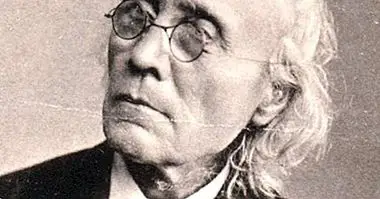Zeigarnik effect: the brain can not bear to be left alone
Television and movies are full of unfinished stories that leave us with the sensation of suspense. Chapters that end the cliffhangers to encourage us to keep abreast of what will happen, parallel stories that are developing stumbling blocks, second, third and fourth parts of a movie, etc.
Something similar happens with the projects that we left unfinished. In general, the feeling of not having seen something finish that was started leaves us feeling unpleasant . Why? To understand this we can resort to a phenomenon called Zeigarnik effect .
What is the Zeigarnik effect?

At the beginning of the 20th century, a soviet researcher called Bluma Zeigarnik I was working with the psychologist Kurt Lewin when he called attention to something very curious that I had observed: the waiters seemed to remember the orders of the tables that had not yet been served or paid better than those that had already been made.
That is to say, that the memory of the waiters seemed to give a higher priority to evoke information about unfinished orders, regardless of whether they had started earlier or later than those that had already been delivered and paid. Memories of finished orders were more easily lost .
Bluma Zeigarnik was dedicated to experimentally verify if the memories about inconclusive processes are stored better in the memory than the rest of the projects. The result of this line of research undertaken in the 1920s is what is known today as Zeigarnik effect.
Experimenting with memory
The study that made the Zeigarnik effect famous was made in 1927. In this experiment, a series of volunteers had to successively perform a series of 20 exercises, such as math problems, and some manual tasks. But Bluma Zeigarnik was not interested in the performance of the participants or the success they had when undertaking these small tests. Simply, focused on the effect that interrupting these tasks had on the participants' brains .
To do this, he made the participants stop solving the tests at a certain point. After, he found that these people remembered better data about the tests that had been left halfway , regardless of the type of exercise required to be resolved.
The Zeigarnik effect was reinforced with the results of this experiment. Thus, it was considered that the Zeigarnik effect is a tendency to remember better the information related to unfinished tasks. In addition, the studies of Bluma Zeigarnik were framed in the field theory of Kurt Lewin and had influence on the theory of Gestalt.
Why is the Zeigarnik effect relevant?
When cognitive psychology emerged in the late 1950s, the interest of this new generation of researchers shifted back to the study of memory, and they took the Zeigarnik effect very much into account. The conclusions drawn by Bluma Zeigarnik from this experiment were extended to any learning process. For example, it was hypothesized that an effective study method should include some pauses, to make the mental processes that intervene in the memory store the information well.
But the Zeigarnik effect was not only used in education, but in all those processes in which someone has to "learn" something, in the broadest sense of the word. For example, in the world of advertising served to inspire certain techniques based on the suspense associated with a brand or product : began to create advertising pieces based on a story that is presented in pieces, as fascicles, to make potential customers memorize a brand well and transform the interest they feel to know how the story is resolved by interest in the product that is offered.
The Zeigarnik effect and the works of fiction
The ads are very short and therefore have little room for maneuver to create deep stories that generate interest, but this does not happen with the works of fiction that we find in books or on screens. The Zeigarnik effect has also served as a starting point to achieve something that many fiction producers want: Loyalty to the public and create a group of fervent followers of the story that is being told .
Basically, it is about facilitating that there are people willing to dedicate a significant portion of their attention and their memory to everything related to what is being told. The Zeigarnik effect is a good handle to achieve this, since it indicates that the information about the stories that have not yet been discovered in their entirety will remain very much alive in the memory of the public, making it easy to think about in any context and generating beneficial side effects: discussion forums in which there is speculation about what will happen, theories made by the fans, etc.
Missing evidence to demonstrate the Zeigarnik effect
Despite the relevance that the Zeigarnik effect has had beyond academic environments, the truth is that it is not sufficiently proven to exist as part of the normal functioning of memory . This is so, firstly, because the methodology used in psychological research during the 1920s did not meet the guarantees that would be expected from this field today, and secondly because attempts to repeat Bluma Zeigarnik's experiment ( or similar) have yielded disparate results that do not point in a clear direction.
However, it is possible that the Zeigarnik effect exists beyond the mechanics of the storage of memories and has more to do with human motivation and its way of interacting with memory . In fact, everything we memorize or try to remember has a value depending on the interest that we have for the information that we try to incorporate into our memory. If something interests us more, we will think more about it, and that in turn is a way to reinforce memories by mentally "reviewing" what we have memorized before.
In short, to consider whether the Zeigarnik effect exists or not, it is necessary to take into account many more factors than the memory itself. It is a conclusion that allows you to shelve the issue, but, in the end, the simplest explanations are also the most boring.



















